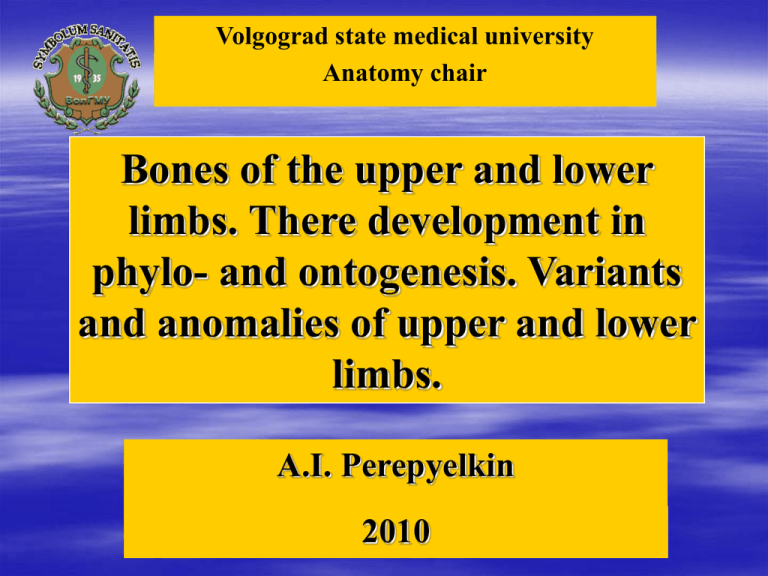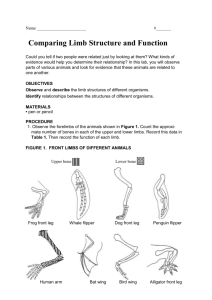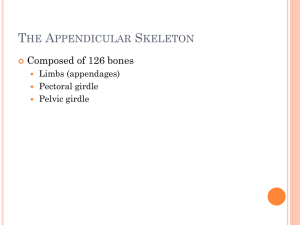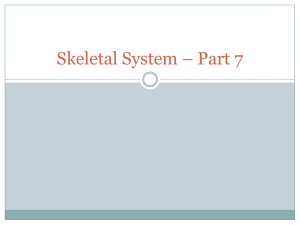
Volgograd state medical university
Anatomy chair
Bones of the upper and lower
limbs. There development in
phylo- and ontogenesis. Variants
and anomalies of upper and lower
limbs.
A.I. Perepyelkin
2010
The upper and lower limbs.
One of the paired appendages of the body
used in locomotion or grasping. In humans,
an arm or a leg (upper limb or lower limb)
with all its component parts (e.g. arm,
forearm, and hand); called also membrum
[NA] and, formerly, extremitas.
Phylogenesis
A prototype of limbs of
the vertebrate are pair
fins of fishes which consist
from cartilages rays and
represent the simple
flexible lever formed
under the influence of
movement in the liquid
environment.
Phylogenesis
The scapula
The primitive reptilian shoulder girdle
comprises a dorsal element—the
scapula — and two ventral elements,
of which the anterior (cranial) is the
precoracoid and the posterior (caudal)
is the coracoid. The primitive girdle of
the lower limb also possesses three
elements, of which the ilium is
homologous with the scapula, the
pubis with the precoracoid and the
ischium with the coracoid. The
clavicle, which is a membrane bone
and therefore morphologically distinct
from the others, is an additional
element in the shoulder girdle and is
not represented in the pelvic girdle.
Phylogenesis
The scapula
The clavicle is absent in
animals in which the forelimbs
are used principally or entirely
for progression, e.g. the
ungulates and carnivores, but
it is present and well
developed in animals which
use the limb for prehension,
e.g.
many
rodents,
the
primates and man.
Phylogenesis
At ground animals in
connection with living
conditions there is a
transformation of a fin into
five-fingered limbs.
Phylogenesis
The skeleton of the free
limb ground vertebrate
owing to transition to
other way of life strongly
changes, though the
radiant structure peculiar
to fishes, at them
remains, being reduced
to five rays.
Phylogenesis
The skeleton of each limb is
divided into four main parts:
the zonoskeleton,
comprising the scapula and
clavicle (as a unit) and the hip
bone;
the stylopodium,
comprising the humerus and
femur;
the zygopodium,
comprising the radius and ulna
and the tibia and fibula;
and the autopodium,
comprising the hand and the
Phylogenesis
The man, unique of all
primaties, goes in
vertical position,
leaning only against
back limbs which
became lower at it,
being on continuation of
a vertical axis of a body.
Phylogenesis
The forward limbs which have
become at the person owing to its
vertical position, have lost the
function of the locomotion. Owing to
the labour activity which has allocated
the person from circle of animals, they
have turned in grasping organ of the
body adapted for performance of
various and thin movements,
necessary for operation. Though
forward limbs carry out catching
function at monkeys, only at the
person hand became the organ of the
work.
Phylogenesis
The hand is adapted to labour activity. The
carpal bones decrease. On the contrary,
fingers are extended and become rather
mobile. The thumb is set aside and can be
opposed to all other fingers, including and V
finger which a monkey cannot do. Some of
them cannot reach a thumb not further III
finger. Besides a thumb of them is short.
Owing to such structure of the hand of the
man is capable not only to grasp a subject
how it takes place at anthropoids, but also to
clasp it, what is of great importance for
catching functions of the hands during the
work. All these features of a structure of the
upper limb of the person have resulted from
improvement of a hand in the course of
labour activity. Therefore, how the Frederick
Engels said, a hand it is organ of work and at
the same time is its product.
Phylogenesis
The lower limbs of the person
serve only for the body movement
in the space and at the same time
they support everything which is
above them. Therefore bones of the
lower limbs are more thickly and
massive. The mobility between
them is less, than at the upper
limbs.
Phylogenesis
Foot as a final support of a body
has lost properties the grasping foot
which are available for monkeys.
Foot has got the form of the arch: a
kind of a spring smoothing pushes
and concussions in the process of
walking and the running.
Embryology
The first rudiments of limbs at the
person appear on 3rd week of embryonal
lives in the form of horizontal ledges on
each side bodies of the germ, reminding
fins of fishes. Ledges extend in the round
plate (a rudiment of a hand and foot), in
which it is not yet possible to distinguish
fingers. Thus, the development of
separate links of limbs proceeds in
following order: at first the distal links,
then averages and, at last, the proximal as
though from a trunk grows at
development of the upper limb at first the
hand, then a forearm and, at last, a
shoulder. So, the hand appears from the
trunk. The development of the lower
limb take places in following order: the
foot, the shin and the hip.
A human embryo about 9 mm. long.
At end of fifth week. (Drawn from
stereoscopic photograph of the
embryo after fixation.)
Towards the end of the fourth
week the limbs appear as
small elevations or buds from
a slight lateral ridge at either
side of the trunk. The upper
limb bud appears on the
lateral body wall at the level
of the lower cervical
segments and the lower limb
bud at the level of the lumbar
and upper sacral segments.
Each bud consists of a core
of somatopleuric
mesenchyme covered by
ectoderm; at the apex of the
limb bud the ectoderm forms
a ridge, the apical ectodermal
ridge.
The example of some
pathology. This is sequence
of development. The first
appears hand from the
trunk. The hand appears
and something went
wrong. That interfered
with of normal
development of upper
limb.
The upper and lower limbs
are constructed after a
common type, but the
different functions for
which they have become
adapted in man have led to
structural differences of a
very definite kind. Each
limb has a girdle, which
connects it to the trunk, and
three segments.
The terminal segment in the upper limb is
the hand which is specially adapted for
prehension. In the lower limb the terminal
segment is the foot which is primarily
adapted to constitute an efficient
supporting base for the body in the erect
attitude, but it is, at the same time,
constructed in such a manner as to
facilitate locomotion. In order to obtain
the full benefit of the prehensile character
of the hand, the upper limb is characterised
by the wide range of movement which it
enjoys—in some situations, e.g. the
shoulder joint, actually at the expense of
stability.
In the lower limb, on
the other hand, the demand
for stability is the prime
factor, and stability is
assured, even although
some degree of mobility
may be sacrificed for the
purpose.
The shoulder girdle
The bones by which the upper
and lower limbs are attached to
the trunk constitute,
respectively, the shoulder and
pelvic girdles. The shoulder
girdle, which is formed by the
scapulae and the clavicles, is
deficient both in front and
behind. In front, however, it is
completed by the upper end of
the sternum, with which the
medial ends of the clavicles
articulate. Behind, the scapulae
are separated from each other
by a wide gap and are
connected to the trunk by
muscles only.
The pelvic girdle
The pelvic girdle is formed by
the hip bones, which articulate
with each other in front at the
pubic symphysis so that the
girdle is complete anteriorly.
Posteriorly the girdle is
incomplete, but the gap is filled
by the upper part of the sacrum,
with which the hip bones
articulate. The pelvic girdle,
with the sacrum, forms a
complete ring, massive and
comparatively rigid, in marked
contrast with the lightness and
mobility of the shoulder girdle.
The upper limb
The scapula
The scapula is a large, flattened,
triangular bone which lies on the
posterolateral aspect of the chest wall,
covering parts of the second to the
seventh ribs. It presents for
examination costal and dorsal surfaces,
upper, lateral and medial borders,
inferior, superior and lateral angles and
three bony processes., viz., the spine,
its continuation the acromion, and the
coracoid process. The lateral angle is
truncated and bears the glenoid cavity
for articulation with the head of the
humerus. This part of the bone may be
regarded as the head, and it is
connected to the plate-like body by an
inconspicuous neck.
The scapula
Structure: The head,
processes, and thickened parts
of the scapula contain spongy
bone; the rest consists of a
thin layer of compact bone.
The central part of the
supraspinous fossa and the
greater part of the
infraspinous fossa are thin;
occassionally the bone is
wanting in these situations,
the gaps being filled by
fibrous tissue.
The clavicle
The clavicle lies almost horizontally at the
root of the neck and is subcutaneous
throughout its whole extent. It acts as a
prop which braces back the shoulder and
enables the limb to swing clear of the
trunk and transmits part of the weight of
the limb to the axial skeleton. The lateral
or acromial end of the bone is flattened
and articulates with the medial side of the
acromion, whereas the medial or sternal
end is enlarged and articulates with the
clavicular notch of the manubrium sterni.
The shaft is gently curved and in shape
resembles the italic letter f, being convex
forwards in its medial two-thirds and
concave forwards in its lateral third. The
inferior aspect of the intermediate third is
grooved in its long axis.
Humerus (плечевая кость)
The humerus is the longest
and largest bone of the
upper limb. It comprises
expanded upper and lower
extremities and a shaft. The
rounded head occupies the
upper and medial part of
the upper end of the bone.
The lesser tubercle
(tuberosity) projects from
the front of the shaft, close
to the head, and is limited
on its lateral side by a wellmarked groove.
Humerus (плечевая кость)
The upper end of the humerus
consists of the head, and the greater
and lesser tubercles.
The head of the humerus forms rather
less than half a sphere, and its smooth
surface is covered with hyaline
articular cartilage in the unmacerated
specimen. When the arm is at rest by
the side, it is directed medially,
backwards and upwards to articulate
with the glenoid cavity of the scapula.
The humeral articular surface is much
more extensive than the glenoid cavity,
and only a portion of it is in contact
with the cavity in any one position of
the arm.
Humerus (плечевая кость)
The anatomical neck of the
humerus immediately adjoins the
margin of the head and forms a
slight constriction, which is least
apparent in the neighbourhood of
the greater tubercle. The upper end
of the humerus joins the shaft at
the surgical neck which is closely
related on its medial side to the
axillary nerve and posterior
humeral circumflex artery.
Humerus (плечевая кость)
The lower end of the
humerus, which constitutes
the condyle, is expanded
transversely, and presents
articular and non-articular
portions. The articular portion
takes part with the radius and
the ulna in the formation of
the elbow joint. It is divided
by a faint groove into a
lateral, convex surface,
termed the capitulum, and a
medial, pulley-shaped
surface, termed the trochlea.
The skeleton of the hand
The carpus comprises eight short bones,
which are arranged in a proximal and a
distal row, each containing four bones.
The bones of the proximal row are named,
from the lateral to the medial side, the
scaphoid, lunate, triquetral and pisiform;
those of the distal row, the trapezium, the
trapezoid, the capitate and the hamate. Of
these, the pisiform is placed on the palmar
surface of the triquetral and is separated
from the other carpal bones, all of which
articulate
with
their
immediate
neighbours. The other bones of the
proximal row form an arch convex
proximally, which articulates with the
radius and the articular disc of the inferior
radio-ulnar joint. The concavity of the
arch is directed distally and forme a
mortise for the proximally projecting parts
of the capitate and hamate bones. In this
way the two rows are locked to each other
and stability is assured.
The skeleton of the hand
The
metacarpus
comprises five metacarpal
bones,
which
are
numbered from the lateral
to the medial side. They
are miniature long bones,
and each possesses a
rounded head, a shaft and
an expanded base.
The skeleton of the hand
The phalanges are fourteen in number,
three for each finger and two for the
thumb. Each has a head, a shaft and a
base or proximal end. In each the shaft
tapers to its distal end and its dorsal
surface is convex from side to side. The
palmar surface is flattened from side to
side, but is gently concave forwards in
its long axis. The bases of the proximal
phalanges are marked by concave, oval
facets for articulation with the heads of
the metacarpal bones. Their heads are
pulley-shaped and encroach farther on
the palmar than on the dorsal surfaces.
Ossification of the bones of the hand
Knowledge of the
date of the ossification
of the hand bones
helps to determinate
of the biological age
of the patient in the
clinical practice.
The lower limb
Hip
The hip bone is a large,
irregularly shaped bone,
constricted in the middle and
expanded above and below. Its
lateral surface is marked near
its middle by a deep, cupshaped hollow, termed the
acetabulum, which forms a
secure socket for the rounded
head of the femur. Below and
in front of the acetabulum the
bone presents a large, oval, or
triangular gap, termed the
obturator foramen. Above the
acetabulum the bone forms a
wide, flattened plate, with a
long, curved upper border
termed the iliac crest.
Hip
The hip bone articulates in front with
the corresponding bone of the opposite
side and the two bones form the pelvic
girdles of the lower limbs. Each
consists of three parts, named the
ilium, the ischium and the pubis, which
are connected by cartilage in the young
subject but are united by bone in the
adult; the union of the three parts takes
place in the walls of the acetabulum.
The ilium includes the upper part of
the acetabulum and the expanded,
flattened area of bone above it; the
ischium includes the lower part of the
acetabulum and the bone below and
behind; the pubis forms the anterior
part of the acetabulum and separates
the ilium from the ischium in this
situation; in addition, it forms the
anterior part of the lower portion of the
hip bone and meets the pubis of the
opposite side in the median plane.
The pelvis, so-called from its
resemblance to a basin, is a massive
bony ring interposed between the
movable segments of the vertebral
column, which it supports, and the
lower limbs, upon which it rests; it is
composed of the two hip bones
laterally and in front, and the sacrum
and coccyx behind. It is divided into
the greater (false) and the lesser
(true) pelvis by an oblique plane; this
passes through the promontory of the
sacrum behind and the linea
terminalis, formed by the arcuate
line of the ilium and the pecten pubis
on each side and the pubic crest in
front. These two subdivisions
communicate with each other
through the superior pelvic aperture.
Differences between the male and female pelvis
Sexual characters are more pronounced
in the bones of the pelvis than in any
other bones in the body. The female
pelvis is specially adapted to facilitate
the passage of the foetal head during
parturition and it must therefore
provide more accommodation than is
necessary in the male pelvis, while its
depth must be diminished. The
essential differences are well summed
up by the statement that the male pelvis
is a long section of a short cone and the
female pelvis is a short section of a
long cone. There are, however, very
many differences in detail, most of
which can be referred to these
fundamental distinctions.
Differences between the male and female pelvis
As a whole, the bones of the female
pelvis are more delicate and their
muscular impressions are not so well
marked. The ilia are more vertical and
the distance between the iliac crests is
less in the female. As a rule, the iliac
fossae are shallower and the curves of
the crest, as seen from above, are not so
pronounced. The prominence of the
hips in the female may be attributed, in
part, to the sexual characters of the
ilium.
Differences between the male and female pelvis
The superior aperture of the lesser pelvis is larger in the female and is
more nearly circular in outline; in the male it is typically heart-shaped.
The cavity of the female pelvis is wider and shallower, and, in the
production of this general difference, the following factors are to be
noted. (1) The sacrum is shorter and wider in the female and its upper
part is straight. (2) The distance between the two pubic tubercles is
greater in the female. (3) The sciatic notches are wider and the spines
of the ischia do not project inwards to the same extent as they do in
the male.
The inferior aperture is larger in the female, since (1) the pubic arch is
wider and more rounded; whereas in the male it is more pointed and
usually much less than a right angle; (2) the ischial tuberosities are
more everted; and (3) the coccyx is more movable.
The male pelvis possesses one positive sexual character: the margins
of the pubic arch are more everted, owing to the larger size of the
crura of the penis.
The following additional differences should also be mentioned. (1)
The acetabula are smaller in the female: they are wider apart and face
more definitely forwards. * As a result the transverse diameter of the
acetabulum is distinctly less than the distance from its anterior margin
to the pubic symphysis. In the male, on the other hand, the two
measurements are practically equal
Differences between the male
and female pelvis
The obturator foramen is shorter in the female and
tends to be triangular in shape. In the male it is more
nearly oval in outline, but this difference is not of great
value as a sexual character. The pre-auricular sulcus is
better developed in the femaleilium, and this is
presumably associated with the existence of a more
movable sacro-iliac joint. Despite assertions to the
contrary, the auricular surface of the sacrum extends on
to the third sacral vertebra in both sexes.
Four main types of female pelvis are recognisable according to the
shape and dimensions of the superior and inferior apertures, shape
and depth of the cavity of the lesser pelvis, dimensions and
inclination of the sacrum and other characteristics. The gynaecoid
type of pelvis displays the typical characteristics of the female as
described above. The android type approaches more to the typical
male type with a heart-shaped superior aperture, somewhat funnelshaped pelvic cavity, narrow pubic arch and long narrow sacrum. In
the anthropoid type the superior aperture is oval, the anteroposterior
exceeding the greatest transverse diameter, the cavity is deep, the
inferior aperture is long and narrow but the angle included by the
pubic arch approaches 90°. In the platypelloid type the superior
aperture has a greater transverse than anteroposterior diameter, the
inferior aperture is short and wide, the walls of the lesser pelvis
diverge as they pass downwards and the pubic arch is wide. Many
pelves are intermediate between these types. Some relation exists
between the body build and the possession of a gynaecoid or
android type of pelvis.
Femur
The femur, or thigh bone, is the
longest and strongest bone in the
body. It possesses a shaft and
two extremities. The shaft is
almost cylindrical in most of its
length, and is curved with a
forward convexity. The head,
which is rounded, can easily be
distinguished from the widely
expanded lower end: it projects
from the medial side of the
upper end of the shaft.
In the erect posture the femora are placed
obliquely. Their heads are separated by the
breadth of the lesser pelvis and their shafts
incline downwards and medially, so that the
medial sides of the two knees almost touch.
As the bones of the legs descend vertically
from the knees, the obliquity of the femoral
shafts results in the approximation of the feet
in the erect attitude and the provision of a
narrow base for the support of the weight of
the body. The narrowness of the base detracts
from the stability of the body but greatly
facilitates movements and increases the speed
with which they can be executed. The degree
of obliquity of the shafts varies in different
individuals, but is usually greater in women
on account of the greater breadth of the pelvis.
The upper end of the
femur comprises a
head, a neck, a greater
and a lesser
trochanter.
The lower end of the
femur and the upper end
of the two bones of the
leg form the knee joint.
Comparison of the girdles of the upper and lower limbs.—The importance of mobility in the
upper limb as contrasted with the necessity for stability in the lower limb is well illustrated
by the more obvious differences which exist between the two girdles.
Girdle of Upper Limb.
Consists of two separate bones, viz., the scapula and the clavicle.
Reaches the axial skeleton only at the sternoclavicular joint.
Is not directly connected to its fellow of the opposite side, except by the
interclavicular ligament.
Has a shallow fossa for the head of the humerus.
Girdle of Lower Limb.
Consists of a single bone, viz., the hip bone.
Articulates with the vertebral column at the sacro-iliac joint.
Articulates with its fellow of the opposite side at the pubic symphysis.
Has a deep cup for the head of the femur.
The fracture of the left
clavicle
The clavicle is very frequently
fractured. The most common
cause is indirect violence, as the
result of force applied to the
hand or shoulder, and the bone
then gives way at the junction of
its lateral with its intermediate
third, that is to say, at the
junction of the two curves, for
this is its weakest part. draws it
downwards. The medial
fragment, as a rule, is little
displaced.
The greenstick (willow) fracture of the
forearm bones of the 8-ages boy.
The fracture of the distal end of the
radius of the child.
The line of fracture
passes through the
epiphyseal line
(growing zone). So
fracture in children
is known as
epiphysiolisis.
The fracture of the distal end of the
radius of the child.
The fracture is
known as classical
(typical) fracture of
the radius. It is
termed the Colles’
fracture.
The fracture of the shaft of the femur
The fracture of the shaft of the child’s femur
with forms a large callus
Congenital abnormalities of upper and lower
limb
The study of congenital abnormalities is known as
teratology.
Of the causative environmental factors responsible for
congenital abnormalities only a few have so far been
identified. These include radiation, maternal infection,
notably with the virus of rubella (German measles) or
toxoplasma organism, acute folic acid deficiency during
pregnancy and the administration of certain chemicals and
many other factors.
Foetal abnormalities may result from incompatibility of the
maternal and foetal bloods. When an Rh positive foetus is
conceived by an Rh negative mother, the antigen stimulates
the production in the mother of the antibody which passes
through the placenta and adversely affects the foetus.
The radiograph of the patient 5 years old
with congenital dislocation of the left hip
The child with congenital absent of the
both humerus, forearm and hand.
The person with congenital
abnormalities of the upper and lower
limbs










